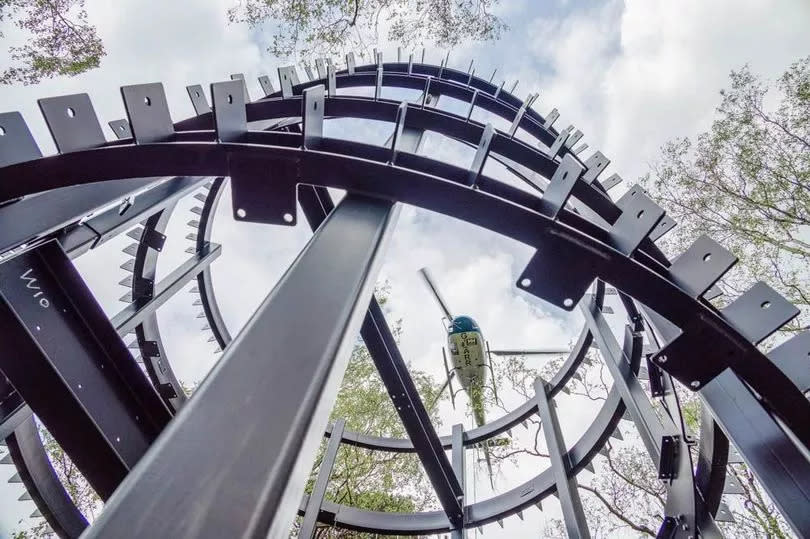New Trossachs Tower inches closer to completion in tourism boost

A new lookout tower was airlifted into place in the Trossachs this week.
There was great excitement as large steel segments and the timber skin of a new scenic tower were airlifted by helicopter and carefully lowered into place on the site credited with being the ‘Birthplace of Scottish Tourism’, above the busy Trossachs Pier at Loch Katrine.
The charitable trust that preserves and operates the historic 124-year-old Steamship Sir Walter Scott is constructing a stunning three-story circular tower with scenic lookouts and connecting raised boardwalks at the landmark Roderick Dhu viewpoint, which was a major attraction in Victorian times.
The viewpoint, home to two wicker huts built in the late 1780s for artists and writers to stay and be inspired by the magic of the Trossachs changing landscapes, has played a major role in establishing Scotland as a tourist destination.
Many leading Victorian artists and writers such as Keats, the Wordsworths and Sir Walter Scott all visited here and published popular works.
Loch Katrine and Scotland were placed firmly on the tourist map following the phenomenal success of ‘The Lady of the Lake’ poem, written by Sir Walter Scott. Like many of his contemporaries, Scott was inspired by the incredible panoramic views during his visit in 1809, and when his epic poem was published one year later, visitors flocked in their thousands to see the landscapes and scenes he described so emotively. The draw of visitors first to Loch Katrine, and then across Scotland saw the birth of Scottish tourism.
Sir Walter Scott’s association with Loch Katrine continued. By now, Scott had developed an entirely new literary genre, historical fiction. One of the most famous Scott novels features stories of the Clan Chief and outlaw Rob Roy MacGregor, born at Loch Katrine in 1693. Scott was interested in learning that a contemporary of Rob, Clan Chief Roderick Dhu and his clansfolk, used the elevated viewpoint as a lookout to signal up the loch to warn Rob Roy of Redcoat soldiers seeking his arrest approaching through the narrow Glen below. This week’s airlift marks the latest phase in developing the lookout tower and two high-quality viewpoints above a giant rock slab outcrop with linking elevated boardwalks and a reinstated path.
Great care is being taken throughout the project to protect the sensitive designated countryside environment, which is why airlifts were needed.
Steel and timbers were flown from a field beside nearby Loch Achray and then carefully guided into place at the peak of the viewpoint.
A 188-metre hand-built stone path with safety post and rail fencing has also recently been completed to connect the Trossachs Pier car park and the scenic tower.
The construction work on the tower and lookouts will continue over the next two months with the opening to the public planned for July.
The project is costing almost £500,000 and is supported by a £231,000 grant from the Rural Tourism Infrastructure Fund (RTIF) via Stirling Council and managed by VisitScotland for the Scottish Government.
Steamship Sir Walter Scott CEO and Lead Trustee James Fraser said: “As we’ve seen with the return of Steamship Sir Walter Scott, restored last year and back for her first full season this year, there is enormous interest in Scotland’s cultural heritage, and the addition of the lookout towers at this classic viewpoint will be another significant addition to the Loch Katrine experience.”
VisitScotland’s Regional Director Lynsey Eckford said: “Our latest insights reveal more than two-thirds of visitors choose Scotland because of our scenery and landscape, and the Roderick Dhu viewpoint will give visitors a fantastic panorama of the beautiful and historic surroundings of Loch Katrine.”
Stirling Council leader, Cllr Chris Kane, said: “Loch Katrine is a real gem in the tourist offering of Stirling, attracting visitors from all over the world and creating valuable, year-round jobs.
“Stirling Council was delighted to support the Trust in accessing funding from the Rural Tourism Infrastructure Fund to improve the facilities available.”

 Yahoo News
Yahoo News 
